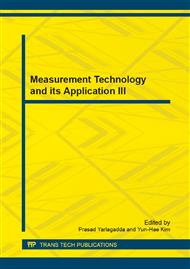[1]
Osaragi, T., Modeling of Pedestrian Behavior and Its Applications to Spatial Evaluation, in Proceedings of the Third International Joint Conference on Autonomous Agents and Multiagent Systems - Volume 2. 2004, IEEE Computer Society: New York, New York. pp.836-843.
Google Scholar
[2]
Teknomo, K., Application of microscopic pedestrian simulation model. Transportation Research Part F: Traffic Psychology and Behaviour, 2006. 9(1): pp.15-27.
DOI: 10.1016/j.trf.2005.08.006
Google Scholar
[3]
Schadschneider, A., et al., Evacuation Dynamics: Empirical Results, Modeling and Applications, in Extreme Environmental Events, R.A. Meyers, Editor. 2011, Springer New York. pp.517-550.
DOI: 10.1007/978-1-4419-7695-6_29
Google Scholar
[4]
Helbing, D., et al. Simulation of pedestrian crowds in normal and evacuation situations. in Pedestrian and Evacuation Dynamics. 2002. Springer.
Google Scholar
[5]
Qiu, F. and X. Hu, Modeling group structures in pedestrian crowd simulation. Simulation Modelling Practice and Theory, 2010. 18(2): pp.190-205.
DOI: 10.1016/j.simpat.2009.10.005
Google Scholar
[6]
Singh, H., et al., Modelling subgroup behaviour in crowd dynamics DEM simulation. Applied Mathematical Modelling, 2009. 33(12): pp.4408-4423.
DOI: 10.1016/j.apm.2009.03.020
Google Scholar
[7]
Ma, W., et al., Modelling passenger flow at airport terminals : individual agent decision model for stochastic passenger behaviour, in SIMULTECH 2012. 2012: Rome.
DOI: 10.5220/0004055701090113
Google Scholar
[8]
Santos, G. and B.E. Aguirre, A critical review of emergency evacuation simulation models. (2004).
Google Scholar
[9]
Cheng, L., et al., Analysis of Passenger Group Behaviour and Its Impact on Passenger Flow Using Agent-Based Model, in IC-MSQUARE. 2013: Prague, Czech Republic. p.4.
DOI: 10.5220/0005086807330738
Google Scholar
[10]
Macal, C.M. and M.J. North. Tutorial on agent-based modeling and simulation. in Simulation Conference, 2005 Proceedings of the Winter. (2005).
DOI: 10.1109/wsc.2005.1574234
Google Scholar
[11]
Zheng, X., T. Zhong, and M. Liu, Modeling crowd evacuation of a building based on seven methodological approaches. Building and Environment, 2009. 44(3): pp.437-445.
DOI: 10.1016/j.buildenv.2008.04.002
Google Scholar
[12]
Kraal, B.J., V. Popovic, and P.J. Kirk, Passengers in the airport : artefacts and activities, in Design : Open 24/7. (2009).
DOI: 10.1145/1738826.1738894
Google Scholar


